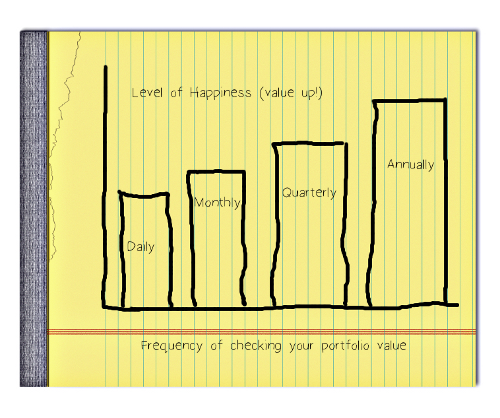The Case For Benign Neglect
Carl Richards, who writes a blog for the New York Times, had an interesting entry last year that I thought bears repeating. Titled "What You Don't Know About Your Portfolio May Help You," Mr. Richards expands on Warren Buffet's statement that "benign neglect, bordering on sloth, remains the hallmark of our investment process."
With 24-hours business cable news channels, and the nightly news sometimes leading with today's Dow Jones Industrial Average rise or plunge, it's easy to get into the mode of "OK, I know what happened to the market today, now what am I going to do about it?" According to Mr. Buffet, perhaps the best thing to "do about it" may be -- nothing!
Let's look at the chart at the top of this post. In rough terms, it illustrates your chances of being happy with your portfolio depending on how often you check its value. Using the S&P 500 index (a broader measure of the market than the DJIA), and looking at the period 1950-2012, we find that:
- If you checked daily, it would be positive 52.8% of the time.
- If you checked monthly, it would be positive 63.1% of the time.
- If you checked quarterly, it would be positive 68.7% of the time.
- If you checked annually, it would be positive 77.8% of the time.
Note that your return does not change based upon your frequency of checking. Add to this the fact that, historically, the market has returned about 10% on an annual basis, while investors have achieved a dismal 3%, and that we're more likely to feel the pain of a loss more acutely than the joy of a gain, then checking your portfolio more frequently seems to be a prescription for hitting yourself on the head with a hammer because it feels so good when you stop. The more bad news you hear, the more inclined you are to "do something" with your investments. Oftentimes, the best thing your financial advisor can do is keep you from doing something. Don't be surprised then, if, when you call us up because the market just dropped 100 points, we respond with a resounding "So?"


 Stout Bowman regularly posts important and interesting information on our blog. Current topics include credit/debit/loans, estate planning, insurance, investing, Medicare, retirement, Social Security and taxes, as well as general information that we think you might find of interest.
Stout Bowman regularly posts important and interesting information on our blog. Current topics include credit/debit/loans, estate planning, insurance, investing, Medicare, retirement, Social Security and taxes, as well as general information that we think you might find of interest.  We have been publishing an email newsletter for our clients and friends since 2016. Links to all of the newsletters can be found on our newsletter page, with the most recent listed first. We try to keep our emails short, so there are typically only three articles in each one, most of which link to other articles in the financial and mainstream press.
We have been publishing an email newsletter for our clients and friends since 2016. Links to all of the newsletters can be found on our newsletter page, with the most recent listed first. We try to keep our emails short, so there are typically only three articles in each one, most of which link to other articles in the financial and mainstream press.  We also have a page on our site for the latest news about our company, notice of any upcoming events, and a market commentary to discuss what our advisors and other financial industry experts conclude about the previous investment performance and what we might expect the markets and the economy will do in the coming months.
We also have a page on our site for the latest news about our company, notice of any upcoming events, and a market commentary to discuss what our advisors and other financial industry experts conclude about the previous investment performance and what we might expect the markets and the economy will do in the coming months.  Many news organizations offer what is called a Rich Site Summary (RSS) feed, a listing of the latest changes to their site's content. We have subscribed to several of these news feeds and present a list of their latest ten articles on a page on this website to save our clients the hassle of going to multiple websites just to see what is available. Currently, we subscribe to
Many news organizations offer what is called a Rich Site Summary (RSS) feed, a listing of the latest changes to their site's content. We have subscribed to several of these news feeds and present a list of their latest ten articles on a page on this website to save our clients the hassle of going to multiple websites just to see what is available. Currently, we subscribe to  At Stout Bowman every investment client is first a financial planning client; it's important to go through that process before we make any professional investment recommendations. Therefore, we strive to make financial planning understandable and comfortable every step of the way. One way to do that is to provide our clients access to financial education resources. To that end, we have subscribed to educational websites to receive their news feeds and present a list of their latest ten articles on a page on this website. Currently, we offer
At Stout Bowman every investment client is first a financial planning client; it's important to go through that process before we make any professional investment recommendations. Therefore, we strive to make financial planning understandable and comfortable every step of the way. One way to do that is to provide our clients access to financial education resources. To that end, we have subscribed to educational websites to receive their news feeds and present a list of their latest ten articles on a page on this website. Currently, we offer